Household kettles through time

Kettles of some sort have been and still are essential for heating water, but their design has changed dramatically over the years. This page describes and illustrates the changes with personal recollections of their pros and cons. It considers cast iron kettles which were standard in Victorian times and before, copper kettles, enamel kettles and whistling kettles through to the streamlined, cordless, thermostatically controlled kettles of today.
____
By the webmaster, based childhood observations and additional research
Cast iron and copper kettles: early 1900s
In Victorian times and the early 1900s, the coal-fired copper was lit once a week to heat water for the weekly wash. All the other hot water of the household - whether for hot drinks, personal washing or keeping the house clean - came from the kettle. This meant that kettles were quite large by today's standards. The kettle was heated on the coal-fired range whenever hot water was required and kept on a trivet close to the range or hung from a swing arm above it at other times, so keeping the water warm.
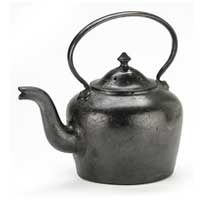
Cast iron kettle
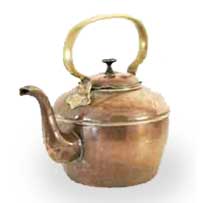
Copper kettle
In the more well-to-do households kettles were made of copper which was a better conductor of heat than cast iron, so allowing it to boil more quickly.
Being metal, the handles of the kettles got hot. So usually they were held through a folded cloth. Alternatively or additionally, string was wound round them or they were made of wood. Although I was born years after their heyday, I do remember seeing a few string-wound handles and can report that the string got very tatty, particularly as it so often got wet.
Kettles were filled through their lids that lifted off.
Aluminium kettles: mid 1900s
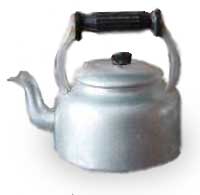
Aluminium kettle with a bakelite handle
I grew up in the 1940s and 1950s, by which time gas ovens and electric ovens had taken over from the old kitchen ranges. These had hobs on top - although I never heard that word used at the time. My parents had a gas oven and our kettle stayed out on its 'hob'.
We had only one kettle throughout my childhood and teenage years. It lasted! It was a simple plain aluminium one that was rather large. In fact it was unnecessarily large which I suppose was a hangover from what my mother was used to from her childhood when so much of the hot water was heated in the kettle. For washing ourselves and our clothes, the hot water came from a coal-fired boiler, so we seldom had to use the kettle for anything other than drinks. This meant that the kettle was seldom more than half full. It filled through the lid that lifted off. For all the time I ever knew, it was caked inside with flaking lime scale. A black Bakelite handle meant that it was never too hot to hold. The knob on the lid was also Bakelite.
The only way to tell how full the kettle was was to look inside or judge its weight.
The kettle heated directly on the naked flame of a gas ring of the 'hob' of the gas oven. Similar kettles with thicker ground bases were available for the hobs of electric cookers.
As the kettle heated it gave off a sound, described as 'singing', and you could tell without watching when it was boiling because the singing would suddenly go quiet. At the same time, steam (actually water vapour) appeared out of the spout.
There was always the danger of being called away to the front door or to a child crying and forgetting that the kettle was on. It could then boil dry and burn its bottom out. This was a well-known problem, although it never happened in our house.
Early whistling kettles
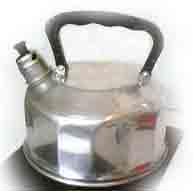
Early whistling kettle showing the separate whistle pushed onto the spout
Some kettles in friend's houses had detachable whistles that fitted over their spouts and gave a whistling alarm when the water was boiling. However as the whistles had to be taken off for filling, two hands were needed - one to hold the handle and the other to take off the whistle, put it down, turn on and off the tap and replace the whistle.
Then once the kettle had boiled, the whistle had to be removed for pouring. Although the Bakelite knob on the whistle was never too hot to handle, the steam wafting out the holes in the whistle feeling uncomfortably hot while the whistle was being taken off.
These kettles were common, but they were fiddly and it was all too easy to forget momentarily where one had put down the whistle. The whistles fitted into the spouts of the kettles by friction, and I found them rather stiff and fiddly to use.
These kettles were generally made of lightweight aluminium with a stronger copper bottom.
Early electric kettles
Some households had kettles that heated with an electric element inside, but they were not common. Those I saw were badly designed because the heating element was large and towards the middle of the kettle so that the kettle had to be filled up to ensure that the element was covered. This was wasteful.
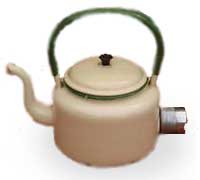
Enamel electric kettle
Such kettles were unattractive because their plugs and sockets were large and their leads were invariably dark and trailing. Again, the only way to know when one was boiling was either to watch it or listen for it to go quiet.
Whistling kettles: mid to late 1900s
It was not until the late 1950s that a better whistling kettle came into the shops.
This type of kettle still filled through its wide spout but the spout opened with a lever action from a button on the handle. The button could be pressed with the thumb while holding the kettle's handle. Consequently the kettle had the advantage that it could be used with one hand while turning on a tap or holding a cup with the other hand.
These types of kettle were very popular indeed, although my mother, who did not like change, kept her old kettle.
When my husband and I set up home in the early 1960s, we considered ourselves very modern and fashionable to have this sort of kettle. Its visible parts - apart from the handle - were shining stainless steel, with a copper bottom to conduct the heat.
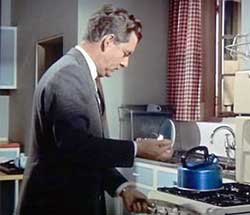
Lighting the gas under a blue anodised whistling kettle. Screenshot from an old film
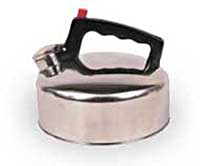
Stainless steel whistling kettle for gas
For as long as the kettle boiled and there was water in it to boil, the steam kept the whistle blowing.
This kettle was boiled on the 'hob' of the gas oven. There were several variations. In particular they came in coloured anodised aluminium as well as stainless steel and with heavy ground bases for use on an electric oven.
Sometime later or possibly around the same time, electric whistling kettles of a similar style came on the market. I wouldn't have one for several reasons: They had to be unplugged and plugged back in every time the kettle was taken to the tap; and they had to be kept out on a kitchen surface all the time with their ugly dark leads permanently showing. However, they were popular. It was just that I disliked clutter.
Thermostatically controlled jug kettles: late 20th century
Only very much later did electric kettles with thermostats arrive to turn themselves off when the water reached boiling point. Then whistling kettles became redundant.
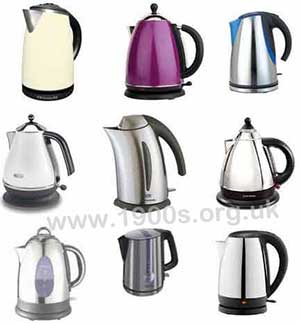
A small selection of the designer cordless kettles returned from an image web search
With the continuing development of heatproof plastics, electric kettles became designer-ware and were normally shaped as jugs with gauges to show how full they were. More attractive white plastic-covered leads became the norm and the connection to the electricity was arranged in the base so that the kettles simply lifted on and off, making them cordless and more readily portable. Their wattage indicates how quickly they will boil. A low power requirement may appeal, but the lower the power, the longer the kettle will take to boil.
Jug kettles were and are practical and easy to use. On the negative side, though, they do seem to need replacing every few years.
The range of jug kettles is vast and there is no shortage of photographs of them on the internet.
| sources | webmaster | contact |
Text and images are copyright
If you can add anything to this page or provide a photo, please contact me.



